There’s a monster in your home and it’s undermining your health. It’s in your car, and at the office, too. And at every restaurant or movie theater you visit.
In fact, there’s a good chance it’s with you at this very moment, sucking the life force right out of you.
What is this health-draining beast?
Your chair.
An avalanche of recent studies finds that sitting for long periods slows your metabolism, deforms your vertebral disks, and contributes to weight gain.
Sitting even lops time off your life expectancy: One 2011 study from the British Journal of Sports Medicine found that after the age of 25, every hour you spend sitting in front of the TV shortens your life by an average of 22 minutes — the equivalent of the damage done by smoking two cigarettes.
Every hour you spend sitting in front of the TV shortens your life by an average of 22 minutes — the equivalent of the damage done by smoking two cigarettes.
At home and in the office, you can reduce the impact of long periods of sitting by taking breaks from your chair every 20 minutes or so, climbing stairs instead of taking the elevator, and otherwise standing whenever possible (standing desks are a great option).
But perhaps the best way to avoid health problems caused by sitting — and keep your posture from becoming permanently chair-shaped — is to incorporate an approach known as stretch-strengthening, says Chris Frederick, coauthor of Stretch to Win.
If you put in four-plus hours a day in front of a computer monitor, chances are you have specific head-to-toe postural changes that need attention beyond what you get on a treadmill or in the weight room.
Broadly speaking, says Frederick, “The flexors (the muscles along the front of your body) get short and tight. And the extensors (the muscles along the back) get overstretched and weak.”
The key to undoing the postural damage that results from desk-dwelling, then, is to do the opposite of sitting: Extend the flexors (that’s the “stretch” part) and contract the extensors (the “strengthening” part).
Even better, says Frederick, do both at once. “When you contract one set of muscles, the muscles on the opposite side of that joint relax deeply, creating a better stretch.”
Frederick designed these six stretch-strengthening drills to help reverse the limitations and weaknesses brought on by long days of desk-dwelling.
Depending on how quickly and vigorously you perform the moves, this do-anywhere workout can function as an at-work or at-home stress reliever, or an invigorating warm-up to more intense exercise.
The Desk-Dweller’s Workout: Stretch Strengthening in Action
Directions: In each of the following exercises, lengthen your back and stabilize your core throughout the movement. These moves should induce a comfortable stretch in your muscles. Stop at the first sign of discomfort in your joints. If one side is tighter than the other, repeat the stretch twice on that side.
For postworkout cool-down or prebedtime relaxation: Exhale and move into each stretch on a six-count, then inhale and move out of the stretch on a three-count.
For preworkout warm-up or invigorating midday stretch: Exhale and move into each stretch on a slow two-count, then inhale and move out of the stretch on a slow one-count.
1. The Hip Saver
- Assume a half-kneeling position with your right knee on a pad and your left foot forward.
- Lengthen your spine and place both hands on your left knee.
- Looking straight ahead, lunge forward until you feel a stretch in the front of your right hip.
- Strongly contract your right glute (think of trying to push your right knee backward).
- Move in and out of the stretch as directed above, then repeat the sequence on the other side.
Tip: To intensify the stretch, reach your right arm directly overhead, or overhead and to the left, as you move into the stretch
2. The Chest Opener
- Stand upright in a door frame and brace your right arm against it.
- Reaching over your head with your left hand, side-bend to the right and take hold of the door frame with your left hand.
- Keeping your spine long, push against the door frame with your right hand and shift your left hip to the left.
- Press against the door frame with your left hand.
- Move in and out of the stretch as directed above, then repeat the sequence on the other side.
Tip: Bend directly to the side as you stretch; don’t twist or bend forward at all.
3. The Back Mobilizer
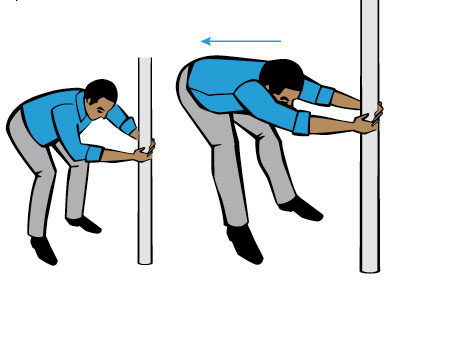
- Assume a shoulder-width stance in front of a waist-high railing, lamppost, or other stationary object.
- Bend forward and take hold of the railing with your hands stacked and your arms slightly bent.
- Bending your knees slightly, lengthen your spine, and arch your lower back slightly.
- Slowly straighten your right leg until you feel a deep stretch along the side of your back.
- Press against the railing with your right hand (think of trying to push the railing away from you).
- Move in and out of the stretch as directed above, then repeat the sequence on the other side.
Tip: Keep your head aligned with your spine throughout the movement.
4. The Huncher’s Helper
- Stand to the right of a door frame or lamppost with your right leg forward in a partial lunge.
- Extend your left arm out to your side, parallel to the floor, and place your left forearm vertically against the door frame.
- Keeping your spine long and your head in a neutral position, press your forearm into the door frame and rotate your chest and shoulders to the left.
- Slowly rotate to the right until you feel a stretch along the left side of your chest.
- Gently retract your left shoulder blade (think of pulling it back and down toward the opposite glute).
- Move in and out of the stretch as directed on previous page, then repeat the sequence on the other side.
Tip: Back off the stretch if you feel any pain in the shoulder joint.
5. The Slouch Reliever
- Stand to the right of a door frame or lamppost with your feet parallel and at shoulder width.
- Keeping your lower back in its natural arch, bend your knees slightly and bend forward at the hips until your torso is parallel to the floor.
- Reach beneath and across your body with your right hand and grip the door frame just above knee height with your thumb pointing upward.
- Place the palm of your left hand against the door frame 12 inches above your right hand, thumb pointing downward.
- Slowly push against the door frame with your left arm, rotating your left shoulder backward and turning your head to face the door frame.
- Move in and out of the stretch as directed on previous page, then repeat the sequence on the other side.
Tip: Most of the rotation in this stretch should come from the chest, shoulders, and upper back. Let up if you feel strain or tension in your lower back.
6. The Shoulder Saver
- Stand to the right of a door frame or lamppost with your right leg forward in a partial lunge.
- Extend your left arm out to your side, parallel to the floor, and place your left forearm vertically against the door frame.
- Keeping your spine long and your head in a neutral position, slowly rotate to the right until you feel a mild stretch along the left side of your chest. Maintain this position for the duration of the movement.
- Keeping your left elbow in contact with the door frame, lift your left hand away from the surface of the door frame as far as is comfortable.
- Slowly lower your hand toward the door frame again.
- Move in and out of the stretch as directed on previous page, then repeat the sequence on the other side.
Tip: Don’t go into a full stretch of the chest before lifting your hand from the door frame — keep it mild.
7. The Anti-Shrug
- Stand upright with your feet parallel and shoulder-width apart.
- With your hands behind you, take an overhand grip on your right wrist with your left hand. If that is too difficult, grips a towels with both hands placed as close together as you comfortably can.
- Bend your head forward and to the left so that your chin is close to your left collarbone.
- Gently pull your right arm downward with your left hand.
- Simultaneously push your right shoulder blade downward, as if doing the opposite of a shrug.
- Move in and out of the stretch, then repeat the sequence on the other side.
8. The Full-Body Desk-Dweller’s Stretch
- Stand with your feet parallel and shoulder-width apart, with the heels of your hands on your upper glutes, fingers pointing toward the floor and thumbs wrapping around your hips.
- Looking straight ahead, inhale deeply for a count of three.
- As you exhale, slowly pull the elbows toward one another, retracting shoulder blades and contracting your core, glutes, and lower back as you shift the hips forward and lean the torso slightly backward.
- Inhale as you slowly return to the starting position.
- Repeat three to five times, going slightly further into the stretch each time. Keep your gaze forward throughout the entire exercise.
This article originally appeared as “The Desk-Dweller’s Repair Plan” in the October 2014 issue of Experience Life.
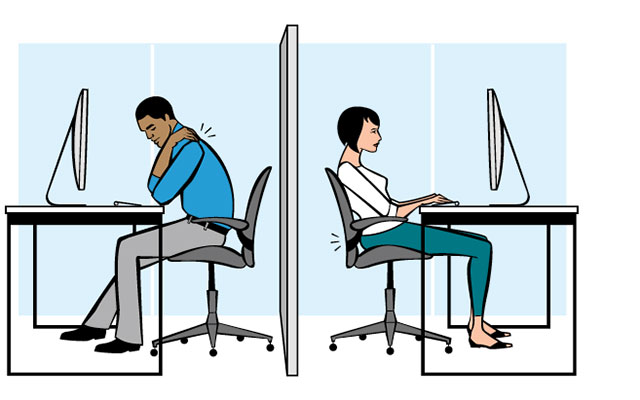
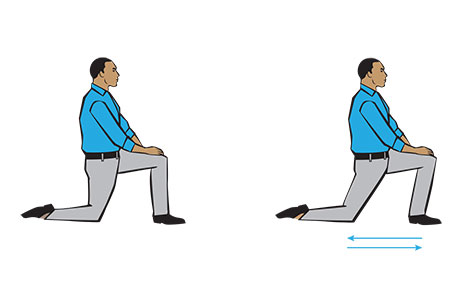

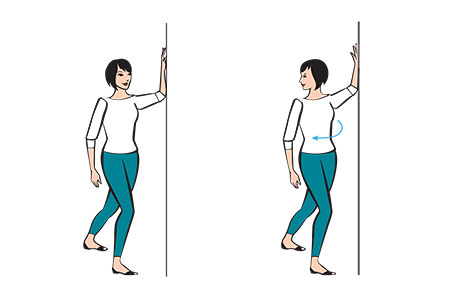

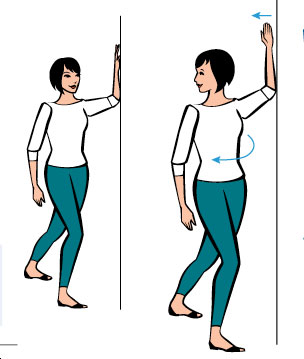
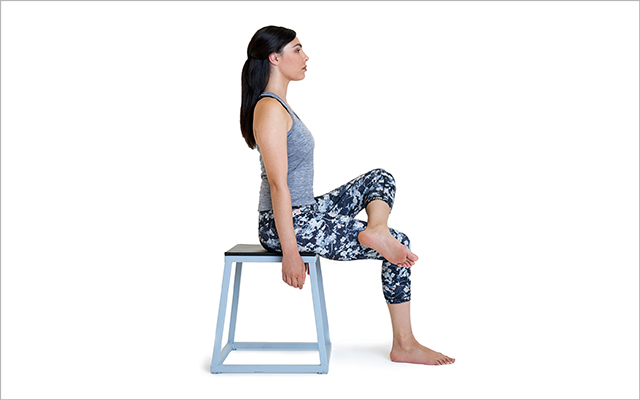
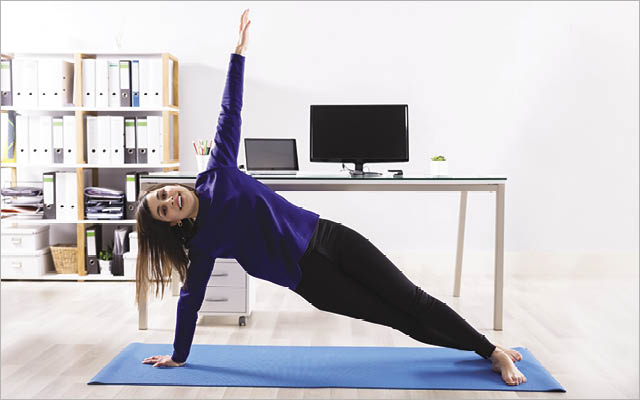

This Post Has 0 Comments